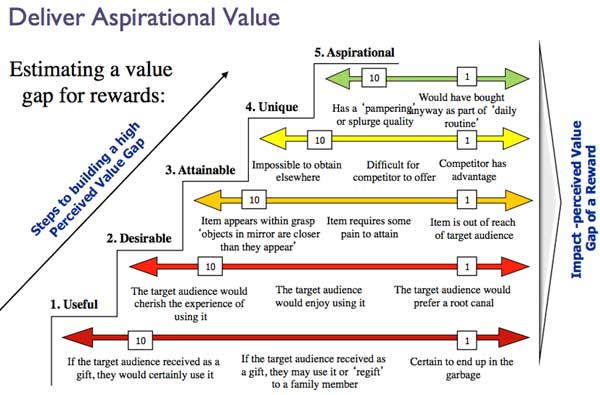To deliver the critical wow factor that draws consumers into loyalty programs and keeps them there, marketers must get inside customers' heads.
Delivering dreams is what inspires wow. But remember, dreaming isn't the only thing that goes on in customers' minds. So, to construct an effective rewards catalog, you'll need to apply a little "brain surgery" to answer the question of balance between the human brain's two hemispheres.
The left brain governs logical, sequential, rational, analytical, and objective thinking. The right brain governs intuitive, holistic, subjective, creative, and "big-picture" thinking. The hemispheres of your brain work together—ideally, in balance—to define the personality of the unique human being you are.
With those thoughts literally "in mind," let's examine five key areas of balance.
1. The Functional vs. the Aspirational
The left brain values the functional. Rewards that fulfill needs will help you pass the "value-detector" test consumers apply to every new program: Wow—that's a deal.
The right brain values the aspirational. Rewards that fulfill dreams will help you pass the "splurge-detector" test: Wow—I couldn't get that anywhere else. They must really appreciate me.
Consider the following chart, which displays a continuum of rising value perceptions:

At the bottom of the scale are rewards driven by needs. Functional rewards are unglamorous, and their perceived value is generally smaller. At the top of the scale are rewards driven by desire. Aspirational rewards can be emotionally compelling, and their perceived value tends to be much greater.
The customer behaviors that you want to elicit increase more significantly after customers receive an aspirational reward than after they redeem a functional reward.
Still, without their attraction to functional rewards, customers may not have gotten into the program in the first place.
2. Customers' Perceived Needs and Goals vs. What They Actually Select
Perception is reality. Customers may not actually want functional rewards, but their left brain will compel them to tell you—and themselves—that they want such rewards, so they'll expect to see them in your catalog mix.
But behavior is also reality, and perception and behavior may be at odds. Generally, consumer research can't effectively tell you how people's perceptions of value relate to their behavior. People will tell you they want cash-back deals or discounts, but such stated preferences don't usually materialize into behavior.
Choosing functional rewards has all the enticement of unwrapping a birthday gift only to find socks and underwear. But also important is perceived bang for the buck: Generally, consumers assign a greater value to things that they can't easily quantify. A customer rewarded with a $20 gift card will assign face value to the card... or possibly less, because of the expectation to receive "a little something extra" as part of the reward experience.
On the other hand, customers rewarded with an unquantifiable champagne breakfast with limousine pickup will assign value to that reward based largely on perception, which is likely to be quite high, and far greater than the cost to you. And some rewards—such as simple recognition—don't have to cost much at all. They just have to mean a lot.
Rewards in the upper spectrum are harder to price, and you may have to conduct tests to optimize a motivating pricing proposition.
3. Perceived Needs and Easily Obtained Rewards vs. Worth-the-Wait Goals
The left brain governs the practical. It seeks rewards that are within reach—if not immediately, then within a reasonable time. Such obtainability makes the program seem real. What's more, quickly attainable redemptions can fuel participation momentum: In general, customers who actively participate and redeem rewards are more likely to stay in the program longer.
The right brain allows customers to dream of far-off goals. Dreams of a pleasant future will also motivate continued participation. But dreams of pampering and excitement cannot themselves fuel a program. If all your program "wow" is off on the horizon, consumers may never embark on the journey in the first place. That's why it's important to have a continuum of reward "costs," from the easily achievable to the wish-list dream.
Rewards at each end of the spectrum speak to each side of the brain.
4. Hard Benefits vs. Soft Benefits
Hard benefits are the quantifiable aspects of your rewards program, and they appeal to left-brain thinkers. Hard benefits include discounts, rewards, cash back, rebate checks, and gift cards.
Soft benefits are the emotional aspects of your program, and they appeal to right-brain thinkers. Offering recognition, special privileges, and exclusive access and experiences creates an emotional connection.
To understand the importance of soft benefits, consider the case of platinum-level frequent-fliers, who earn so many miles they literally can't use them all. Earning miles has become secondary to the frequent-flier perks: seat upgrades, recognition, expedited check-ins, higher levels of service. Soft benefits also deliver the type of wow that differentiates your brand from the competition, and perhaps, even helps define your brand.
5. The Answer of Balance
Just as human personality is dictated by left-brain/right-brain balance, both hemispheres of your rewards program must work together to deliver your brand's unique personality. The wow begins with the brand, because your rewards must resonate with what attracted customers to your brand in the first place.
* * *
If you're still not convinced that the answer to the wow factor is a question of balance, just look at the symmetry and balance of the word itself: wow.
Need I say more?



